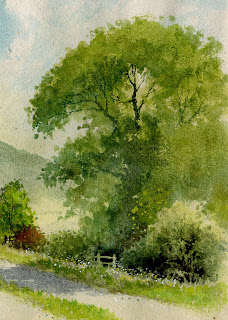Once again, autumn is with us, and the opportunity to indulge in bright, warm colours in our landscape paintings. This time last year I found the striking colours in the Bavarian Alps absolutely mind-blowing, with every day in brilliant sunshine.
This scene shows a track leading to Little Langdale in the English Lake District. I was lucky at the time to encounter snow on the distant fells, and this accentuated the bright colours of the right-hand small tree. For this I used two of my favourite Daniel Smith colours – Aussie red gold, which was applied first and when this was dry I added transparent red oxide. These two work extremely well for autumn scenes. The dark ridge in the middle distance was rendered with Moonglow, another useful colour, and in places I have pulled out the colour with a small sable to indicate lighter patches.
The painting is reproduced in my Landscapes Through the Seasons in Watercolour book, signed copies of which are available from my website
Watch out for those autumn colours and make sure you are armed with the right colours……..and if you get some snow as well, then that’s a great bonus!





